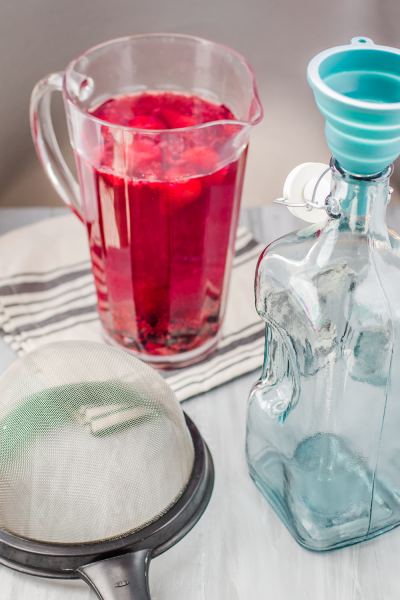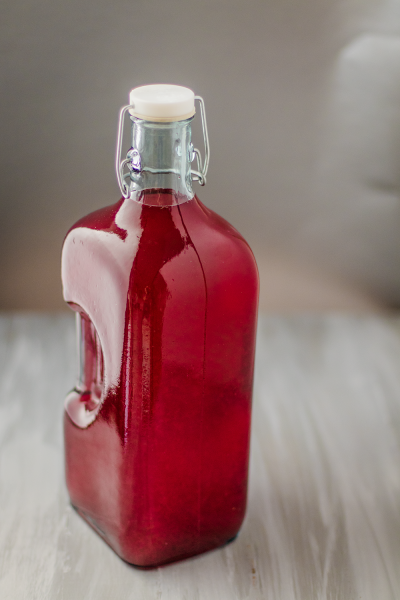How to Make Heavenly Homemade Wine

Making homemade wine from fruit is simple, enjoyable, and worth every last sip. A colorful and tasty addition to any wine rack, fruit wines also make fantastic culinary ingredients for sauces, marinades, salad dressings, and even some desserts. Although making fruit wine is a time intensive process, it makes vinting accessible to those who can’t care for a vineyard or vint grape wines.
Homemade fruit wines make great gifts and provide exotic flavors that are bound to intrigue dinner party guests. So choose your fruit and let the fermenting begin!
When making homemade wine, frozen fruit is required for clean flavors, so this recipe can be made year-round. If you have fresh fruit, freeze it for at least three days before beginning the winemaking process. The initial process involves pouring boiling sugar water over the frozen fruit, which kills any bacteria, foreign yeasts, and unwanted flavors. Most winemaking guides will advise using sodium or potassium metabisulphite for sterilization at this stage, however, to make a completely natural, sulfite-free and organic wine, the freezing/boiling method works effectively.
First, comes the task of choosing which type of wine you would like to make. Strong flavored berries such as blackberries, loganberries, and strawberries produce tasty wines as the tannins in their seeds provide robust and full-bodied flavors. Blueberries make a milder wine, which is very sweet. Stone fruits such as plums and cherries make fantastic wines, especially wilder varieties, as they have a bit of bite to them. Another uncommon but very palatable wine is rhubarb, which is also mild but blends very smoothly with strawberry and loganberry. Apples and pears produce well-rounded homemade wines but tend to be much sweeter and butterier than berry or plum wines. Jim and George’s Home Wine Making, a particularly fantastic guide for beginner’s, offers recipes for several different fruit types.
After deciding on a fruit, considering the sugar to water ratio is key. Yeast (which you will be adding to the wine) feeds on sugar, which produces alcohol. Therefore, the more sugar you add to your wine mixture, the more alcohol will likely be produced. However, you must consider how much sugar the fruit naturally contains. For example, pears contain a lot more sugar per pound that blackberries. Adding too much sugar will give you an extremely sweet wine, because as your yeast begins to gradually die out, nothing will be feeding on the extra sugar. It is therefore also important to pick the correct type of yeast. The WineMaker Magazine’s yeast chart will give you a good idea of how to choose yeast strains for particular types of wines. The homemade wine recipe below provides a sugar to fruit ratio that produces a slightly sweet red wine that would classify in between a port and a merlot.
Homemade Wine Kit

Equipment
3 gallon stoneware crock
Three 1 gallon jugs (recycled Carlo Rossi jugs work very well)
2 airlocks with rubber stoppers and a siphoning tube
Funnel
Fine mesh strainer
Notes: You will also want to wash up used wine bottles, invest in a couple of new corks and a corker if you plan on bottling any wine. The recipe below is for one gallon of fruit wine, which amounts to approximately five 750 ml bottles of wine.
Another note, the process is pictured in a glass pitcher in order to show what your results will look like but you will actually need to use a crock, listed above, rather than a pitcher.
Homemade Wine Recipe
Ingredients
4 pounds frozen fruit
1 gallon water
2 pounds organic sugar
1 teaspoon powdered yeast nutrient (ensures that your yeast has what it needs to be productive)
1 package wine yeast
Directions
Make sure your fruit has been in the freezer for at least three days before beginning the process. Bring your water to a boil and add the sugar. Take the fruit out of the freezer, place in a three gallon crock while you are waiting for the sugar water to boil. CAREFULLY pour the boiling sugar water over the frozen fruit in the crock. Avoid any contact with skin – it will burn badly.

Stir the fruit and sugar water mixture and cover with a cloth and lid or large plate. Do not let any fruit flies into your wine, or it may turn into vinegar.

The next day, mash the berries with your hands, stir in your yeast thoroughly, and cover with a cloth and lid. Keep stirring the must (vinting terminology for the liquid at this stage) in the crock once a day for a week, after which you will be ready to transfer it into the glass jugs.

Place a funnel in your jug, a fine mesh strainer on top of the funnel, and begin ladling the must into the jugs, separating the fruit pulp from the liquid. Leave at least four inches of headspace, and cap with an airlock, which allows oxygen out but nothing into the bottle. Place the bottles out of the direct sunlight where they will not be disturbed.

After about a month, you will have to siphon your wine off of the fruit matter and dead yeast that will have settled at the bottom of the jugs. Place your siphon halfway into the filled jug, which should be on a countertop, being careful not to disturb the matter at the bottom. Place your clean, empty jug on a small stool on the floor, where the other end of the siphoning tube can reach it.
Start your siphon, and let the clear wine fall into the clean jug, gently tipping the jug on the countertop but making sure to keep the matter on the bottom from sloshing into the siphoning tube. Two people are often required for this task; one starting the siphon and feeding the tube into the empty bottle, and one keeping the siphon at the right position in the jug on the countertop. All of your clear wine should fit into a single gallon bottle, with at least an inch of headspace. You may have some extra, which you can use for cooking.

Related on Organic Authority
3 Sustainable Wineries That Will Get You Tipsy While Preserving the Land
5 Fall Wine Harvest Weekends Perfect for Wine Lovers
How to Make Sangria for 4th of July: A Red, Blue, and White Wine Recipe
Images via Karissa Bowers

